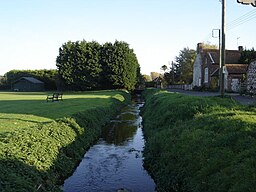River Burn, Norfolk
| River Burn | |
|
The Burn at Burnham Thorpe
|
|
| Country | England |
|---|---|
| County | Norfolk |
| Source | |
| - location | South Creake |
| - coordinates | 52°52′21″N 0°45′50″E / 52.8726°N 0.764°E |
| Mouth | |
| - location | Overy Creek, Burnham Overy Staithe |
| - coordinates | 52°57′40″N 0°43′48″E / 52.9610°N 0.7301°ECoordinates: 52°57′40″N 0°43′48″E / 52.9610°N 0.7301°E |
| Length | 12.3 km (8 mi) |
| Basin | 101 km2 (39 sq mi) |
| Discharge | for Burnham Overy |
| - average | 0.32 m3/s (11 cu ft/s) |
|
Map of the River Burn
|
|
The River Burn (also known as "Nelsons River") is a river in the northwest of the County of Norfolk, in the East of England. From its source to its mouth on the North Coast of Norfolk it is 12.3 kilometres (7.6 mi). The river has a fall of 36 metres to the sea.
The source is one mile south of the village of South Creake, in a small copse west of a bend in London Lane. From the source it runs northeast towards the village of South Creake, where at Fakenham road it turns northwest and run through the village. Gradually the river turns north and runs along the western side of the Burnham road heading towards North Creake.
The river runs through the village of North Creake, crosses under the Burnham Road and heads north across the open countryside towards the ruins of Creake Abbey. This abbey is on the southern edge of the Burnham’s, a mile or so from Burnham Thorpe. It was built towards the end of the 14th century for an Augustinian priory which had inhabited this spot since the 1220s, becoming an abbey shortly afterwards. Creake Abbey is unusual, because although it survived into the 16th century, it never suffered the effects of the Reformation or the dissolution of the monasteries. In 1508, an outbreak of plague killed virtually all the inhabitants, and it was abandoned.
The river runs through a small pool in what were the grounds on the west side of the abbey, and then passes under the lane and out northwards across countryside towards Burnham Thorpe. At Burnham Thorpe the river runs through another pool very close to the site of the Burnham Thorpe Parsonage. That parsonage was the birthplace of Admiral Horatio Nelson. Burnham Thorpe was originally one of a group of seven villages all prefixed with "Burnham" taking their name from the river. It is approximately three miles from the North Norfolk coast, a low, flat coastline of muted colour, of sand and salt-marsh. From the high ground above the village one can see the sea, and it is said that from there you can hear the sound of surf on the sand of the shore.
...
Wikipedia



